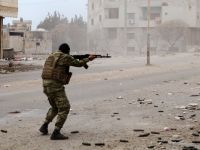(MEBG) - BHP Petroleum is an Australia international oil and gas exploration and production company, (E&P) Australia-based, with a predominant upstream emphasis, and interests and activities in 10 countries. It is a wholly-owned subsidiary and one of the three main interests of the Broken Hill Proprietary Company Limited, one of Australia's largest listed public companies, and one of the world's major diversified resources groups.
BHP’s Petroleum’s international asset base includes major producing assets in Australasia and the United Kingdom, offshore production in the Gulf of Mexico and production in Bolivia, and a major oil and natural gas asset in Algeria.
BHP in Algeria
OHANET:
Ohanet is is located in a remote and desolate gas field, situated approximately 1300 km south east to capital Algiers, and 100 km west of the country’s border with Libya, deep in the Sahara desert. The first discoveries were made in the late 1950s early 1960s. In all, there are wells, 18 of them comprise the Ohanet field.
In 1997 Sonatarch , Algeria’s national oil company, invited foreign companies to bid to undertake capital investment necessary to develop the Ohanet field, which is composed of four gas reservoirs. After several rounds ofnegotiations, BHP managed to build a consortium composed of the following companies: BHP with 60 percent, Japan Ohanet Oil and Gas Co. (a group that includes the Japanese National Oil Corporation, with 50 percent, Itochu Oil Exploration with 35 percent, and Teikoku Oil with 15 percent ) with 30 percent, Petrofac Resources(Ohanet) LLC with 10 percent. The Risk Services Contract ( RSC) was signed with Soantrach on July 3.
The total cost of developing the Ohanet reservoirs will be around US$1.billion, of which BHP’s share is US$618 million). Annual operating costs are expected to be around $36million.
In return the participants will be entitled to recover their investment—together with an agreed fixed profit consideration—over a target eight-year period from the start of production. The Ohanet fields are estimated to contain total proven and probable reserves exceeding 3.4 trillion cubic feet of pipeline quality gas, 107 million barrels of condensate and 116 million barrels of LPG. The structure of the RSC means that BHP’s reserves entitlement fluctuates with movements in hydrocarbon prices and the company expects to book proved reserves in the range of 55 million to 75 million barrels of oil equivalent.
First production is scheduled for October 2003 and peak liquid production will be around 58, 000 barrels per day (bpd). At first it is expected that production rate to 30,400 bpd of condensate, 27,700 bpd of LPG, 655 million standard cubic feet per day(mmscf/d).
Under the terms of the RSC, the joint venture partners will recover their investments and an undisclosed agreed profit within eight years from the start of production, provided production reaches 710 million cf/d of wet gas. A four-year grace period is available in the event that low oil prices prevent full payout. BHP expects to book proved reserves of 55 million-75 million barrels of oil equivalent during the term of the RSC. The joint venture partners are not entitled to the pipeline sales gas, which will be used by Sonatrach, nor to the associated revenue.
The development program also includes the construction of a gas treatment unit and a 236-kilometer pipeline, the acquisition of 3-D seismic data and the drilling of 47 wells.
A joint venture of PetroFac International and ABB Lummus Global, both of the US, has been awarded the $574 million contract for the facilities design, procurement and construction. The program will be carried out on a lump sum turnkey basis. BHP will manage the reservoir engineering, drilling operations and all facilities work.
ROD:
The ROD oil field is locatedin the Berkin Basin region of Algeria, not far from the Ohanet gas field. In 1989 BHP purchased an interest in two contiguous areas, known as blocks 401a/402a. They are located approximately 270 km southeast of Hassi Messaoud, the main oil province of Algeria. A Production Sharing Contract ( PSC) was signed in 1989 between BHP and Sonatrach.
In May 1997 BHP’s drilling program yielded major tresults, with Bir Sif Fatima North field ( BSNF) was the first reservoir to be discovered. BSNF-1 flowed at a rate of 5,600 bpd. Three months later Rhourde Oulad Djemma(ROD) was discovered and yielded 5,500 bpd. Two appraisal wells were drilled and successfully operated.
After geological tests, it was determined that the BSNF field is a ”stretch” of Agip’s Block 403 field. Today ROD, BSNF and BRSE are refereed to as ROD field.
The fourth discovery in April 1988–Sif Fatima North East 1 ( SFNE), provided 21,000 bpd. On 1998 a new promising field was also discovered in the area–Bir Sif Fatima (BSF) with 6,600 bpd.
Reserves of the ROD field are estimated about 300 million barrels. Under Algerian law foreign companies can not receive more then 49 percent of total production from any field, and this is further complicated by the fact that the field is an “extension” of Agip’s field. BHP and Agip have signed a agreement to govern production and operations, which in effect reduced BHP’s share was reduced as a result to only 17.3 percent.
The first regular oil production from the field is scheduled for the first half of 2003. Gross peak production will be 80,000 bpd. The development and operations will be conducted by joint operating entities comprising BHP, Agip asnd Sonatrach. Foreign partners may participate in the field for 25 years. Capital cost for combined development is estimated around $500million, of $190million will be invested by BHP). Operating costs will be about $22.5million a year.
The fields planned facilities are:
1. 19 production wells, 13 water injection wells and 5 gas injection wells.
2. A field gathering system.
3. A central processing facility for processing the well fluids. The crude will be processed to existing Sonatrach pipelines.
4. Floating roof storage tanks for buffer storage of crude.
5. Various facilities – such as gas dehydration plant , gas compression, water treatment unit.
6. Operation support infrastructure
© 2000 Mena Report (www.menareport.com)







